Before you can start preparing the earth for a garden, you will need a few essential gardening tools. When undertaking any project the quality of your tools will set the tone for your experience. The must-have gardening tools will be determined by the kind of soil, garden, plants, location, and landscape you have. If there’s one lesson you should not learn the hard way, it’s this: buy the best quality tools that you can reasonably afford. They will make your gardening journey rewarding and enjoyable. You can thank me later.
Tool categories
There are two basic categories of garden tool: long-handled tools and small hand tools. Before you purchase your long-handled tools, try them out in the store. Give them a check for length and handle size. Is your derriere protruding or are you standing in a dignified, upright position? The handle should be smooth and comfortable. Getting the perfect size long-handled tool will prevent post gardening fatigue and help you enjoy gardening throughout the season.
Long handled tools
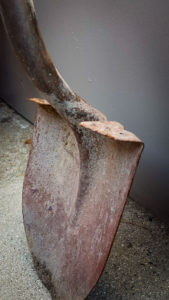
shovel foot
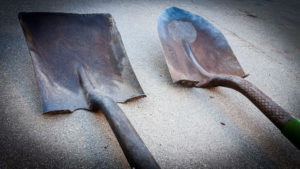
Shovel blade styles
Garden shovel: Shovels come in various shapes and sizes. The most important part of the shovel is that the solid metal blade is securely attached to the handle. The top of the blade must have wide enough foot pads for a foot to comfortably push the sharp business end into the dirt. I prefer a fiberglass or composite handle for shovels as they tend to last the longest.
Spading Fork: Most commonly known as a pitchfork and is suitable for loosening soil, aerating the soil, turning compost, distributing mulch, dividing perennials, sifting potatoes or unwanted roots, and tossing hay. I prefer the D-shaped handle with four prongs. A fork is not essential for a small garden but very useful for large spaces. It is necessary for digging in heavy clay, sandy environments, and thick grassy areas.

Spading fork
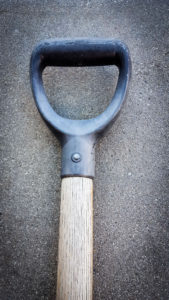
D shape handle
Rakes: The two basic types of rakes needed are a rigid metal gardening ra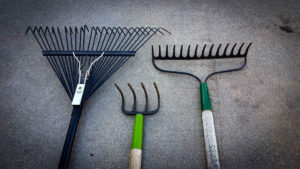 ke with sturdy tines to help you clear debris, and spread or level soil before planting. The second is a bow rake with flexible tines primarily used in the Fall to rake up beautiful leaves.
ke with sturdy tines to help you clear debris, and spread or level soil before planting. The second is a bow rake with flexible tines primarily used in the Fall to rake up beautiful leaves.
Wagon or wheelbarrow: Wagons are a fun sturdy four-wheeled device used to haul children, tools, and soil to your garden. They can save you many trips to the shed. A wheelbarrow is more versatile and has a single front wheel allowing you to dump large loads.. This is not as safe for hauling children but is easily maneuvered by smaller framed individuals.
Hoes: Essential for weed control and covering a lot of ground quickly. There are three types: one that cuts on the push, cuts on the pull, and cuts on both the push and the pull. The draw hoe is the one most people are familiar with. The Stirrup cuts both ways and is essential for weeding small spaces such as raised beds or compact gardens.
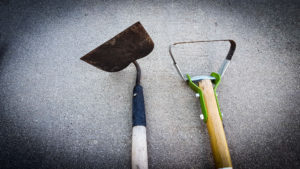
Hoes
Watering Essentials
Watering Can: Without question, you will need the quintessential watering can. Look for one made of galvanized steel that is weather resistant with a large rosette diffuser or rosehead. If you have a problem with hard water, you will want a removable head. I do not recommend getting plastic as they do not last long unless you are going to use them for inside decor.
Garden hose: This is one of the most overlooked items when thinking about a garden. Getting water to your garden is essential. You will need a sturdy, lightweight hose with an adjustable nozzle. A durable, lightweight hose is necessary for convenience to maneuvering around the yard without fatigue. The proper length of the hose is one that reaches your garden, and has a little extra. The nozzle should adjust the water pressure from mimicking a spring shower to pressure washing clay.
Small hand tools
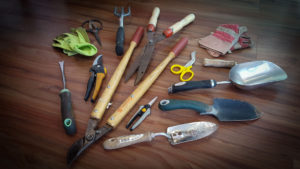
Small Hand Tools
Trowel: Next to the watering can this will be your most used tool. Make sure it has a comfortable handle. Blades come in many sizes and shapes, and your preference will come in time. Early in the season while planting, I prefer a large scoop type trowel. If I am planting a ton of bulbs, I prefer to have one with measured lines that is long, narrow and sharp. If I am just weeding or planting I prefer a medium-sized sturdy shovel type.

Trowel
Pocketknife: Steve always carries a pocketknife, and on many occasions, I’ve asked to borrow it, but this is not my go-to. I prefer a linoleum cutting tool that has a sturdy wooden handle with a tapered curved steel blade. I use this to cut the produce off without harming the plant.
Pruners: This is another tool that will depend on what you are growing in your garden. For woody stems such as roses, raspberries, small trees, or common shrubs you’ll need a pair of bypass pruners. I use Fisker all steel bypass pruning shears. The blade cuts like scissors with a more sturdy handle and thicker blades. Depending on how thick your shrubs are you may want to consider ratcheted blades that minimize the amount of effort needed to cut efficiently.

Small Hand Cutting Tools
Scissors or snippers: A sturdy pair of scissors or trauma shears is frequently used in my gardening repertoire. I use them to cut fresh flowers or trim the fading (also known as deadheading), harvesting peppers, squash, or cutting ornamental grasses.
Gloves: Getting your hands in the bare dirt is part of the fun of gardening, but there are occasions where gardening gloves are required. Neoprene gloves when the conditions are very wet. Leather gloves are best for preventing blisters while doing repetitive raking or hoeing and protects against pointy or prickly materials such as pine needles. Long gauntlets are best for protecting your arms when pruning thorny roses or blackberries. Whichever type of gloves you purchase, make sure but they fit comfortably and that they do not have any protruding seams or edges that may rub while working.
Optional tools
Spray bottle: This is optional but is a perfect remedy for watering seedlings in their early stages. I use this later in the season for distributing self-concocted pest control, in an attempt to keep aphids off my cruciferous vegetables.
Dandelion weeder: This is a sharp forked tip on the end of a long steel rod. When punctured into the ground at a 45-degree angle and rotated in a circular motion, it loosens the soil around the root. Try to pull it out entirely or cut the root deep enough to kill it. Ideal for permanent removal of tap roots, and invasive weeds such as dandelions or thistle.
Vertical gardening: If you have limited space, growing-up is a great alternative. You will need a trellis, stakes, cages and, plant ties. Upward-growing devices are often used to increase a decorative aspect to your garden.
Bucket: You can never have to many buckets in all shapes, colors, and sizes. I use them to carry my tools, harvest produce, remove weeds, transfer dirt, clean tools, soak roots, and my kids love them too.
Caring for your tools
Early spring, before you can plant anything and your feeling anxious to get your hands in the dirt is the best time to tend your tools. Throughout the growing season and after each use, ensure your tools are clean, dry, and properly stored. They don’t have to sparkle but knock off any soil that remains. My favorite way to store my small hand tools is in buckets that are easy to put away, and keeps my favorite most used tools together.
At the end of the season before storing them in a cool and dry place, polish the metal parts with steel wool and oil to prevent rust. You will thank yourself when you pull them out for another gardening season. If you find a rusty tool, use a wire brush to remove it. Also keeping your tools sharp will prevent gardening fatigue and save you some elbow grease. If you have wooden handles, make sure to sand, varnish, and oil as needed to keep them smooth. Nobody likes splinters.
Getting tools on a budget
Getting tools does not have to break your budget. Many tools can be found at yard sales, estate sales, neighborhood apps, or online sources such as your local newspaper, Facebook, and Craigslist. Start with the basics of what you need and grow from there. Gardening is a practice, every day is an opportunity to learn something new.
As you grow in your garden, you will develop your favorite tools. It’s better to have a few tools that you love than many that you have to replace every season. Proper tools also allow you to enjoy your gardening experience and save you needless effort. High-quality tools will last many seasons if cared for properly.
What are your favorite gardening tools?
~Janine


